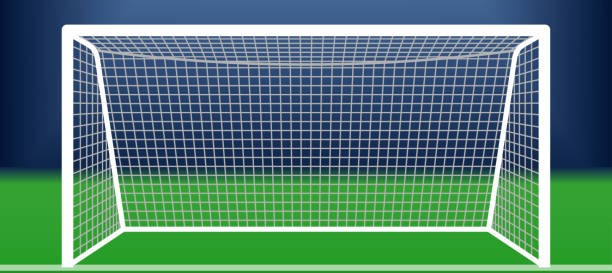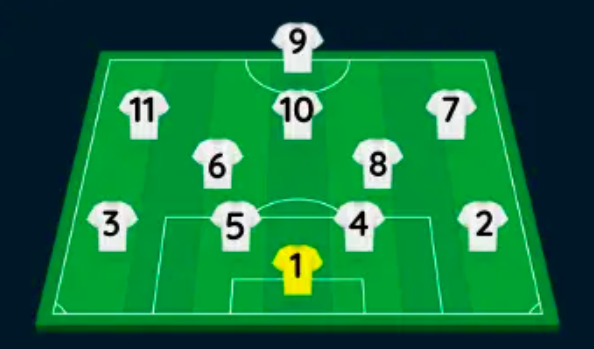













JERSEY NUMBERS.

In football, jersey numbers play an important role in identifying players on the field. Each player wears a
number on the back of their jersey, and sometimes on the front or shorts, making it easy for referees, teammates,
coaches, and fans to recognize them. The tradition and significance of jersey numbers vary based on player position
and sometimes the player's status or legacy. Here's a detailed explanation of the role and importance of jersey
numbers in football:
Purpose of Jersey Numbers:
-
▫ Identification: Numbers allow quick identification of players during a match. Referees use these numbers to note fouls or issue cards, while coaches and teammates use them to communicate strategy.
▫ Positions: Historically, specific numbers were associated with certain positions on the field, though modern football has evolved to allow more flexibility.
In the traditional 11-player setup, numbers were closely tied to specific roles on the field. Here's a breakdown of classic numbering for each position:
Goalkeeper:
-
▫ The number 1 is almost always worn by the goalkeeper, the player guarding the goal.
Defenders (Numbers 2 to 5):
-
▫ 2 (Right Back): Typically worn by the right fullback, who defends the right side of the field.
▫ 3 (Left Back): Usually worn by the left fullback, who defends the left side.
▫ 4 (Center Back): Often worn by a central defender, responsible for stopping opposing attackers.
▫ 5 (Center Back/Defensive Midfielder): Another central defender or sometimes a defensive midfielder.
Midfielders (Numbers 6 to 8):
-
▫ 6 (Defensive Midfielder): The holding or defensive midfielder, tasked with protecting the defense and breaking up opposition attacks.
▫ 7 (Right Midfielder/Winger): Usually an attacking midfielder or winger playing on the right side of the field.
▫ 8 (Central Midfielder/Box-to-Box): Worn by a central midfielder, often involved in both defense and attack.
Forwards (Numbers 9 to 11):
-
▫ 9 (Striker): Traditionally the center forward or main goal scorer, positioned to lead the attack.
▫ 10 (Playmaker/Attacking Midfielder): The number 10 is often worn by the team’s most creative player, responsible for orchestrating attacks and often regarded as the "playmaker."
▫ 11 (Left Midfielder/Winger): Typically a left-sided winger or attacking midfielder who plays wide.
Modern Flexibility in Jersey Numbers:
-
While the traditional numbering system still exists, modern football has become more flexible, and players often wear numbers outside of these classic positions. This can be due to personal preference, availability, or squad rotation. For example:
▫ A striker might wear number 7 instead of the traditional 9.
▫ A central defender might wear number 6 rather than 4 or 5.
Squad Numbers in Modern Football:
-
In professional football, players are often assigned squad numbers at the start of a season or tournament, and they wear these numbers throughout the competition. Key aspects of modern squad numbers include:
▫ Fixed Numbers: Players keep the same number for the entire season, which is used across different competitions.
▫ Wider Range of Numbers: Squad numbers in modern football can range from 1 to 99, although the most common range is 1-30.
▫ No Position Restrictions: Players can wear any number that is available, even if it doesn’t align with their traditional position (e.g., a striker might wear 20).
International Football Numbering:
-
▫ In international tournaments, the numbers 1-23 are usually reserved for the final squad, with 1 reserved for a goalkeeper. Players generally wear numbers between 1 and 23, although some tournaments now allow for numbers up to 26 or 30.
Referees and Jersey Numbers:
-
▫ Referees and officials also use jersey numbers to identify and call out players when issuing yellow or red cards. Players' numbers are also recorded in match reports to track statistics like goals, assists, and disciplinary actions.
Summary of Jersey Numbers:
-
▫ Jersey numbers help identify players and are linked to traditional positions, though modern football allows more flexibility.
▫ Numbers like 7, 9, and 10 have special significance, often associated with star players in specific positions.
▫ Numbers are assigned at the start of a season and remain fixed, with famous numbers sometimes retired in honor of legendary players.
Jersey numbers in football carry both practical significance for identification and symbolic value tied to the history and
legacy of the game.




























